Page Contents
by Ross Geller
Oral health is usually avoided and underestimated by physicians, dentist and pregnant women. But researchers have suggested that some prenatal oral conditions do have an adverse effect on the child. Like periodontitis has an association with preterm birth and low birth weight and high level of cariogenic in the mother increases the chances of dental caries in the infant. Routine screening for oral risk, counseling on proper oral hygiene and timely dental treatment/ diagnosis are a must have for every pregnant woman as it reduces the prenatal outcomes.
Listed below are few dental strategies for pregnant woman as during this time women are more motivated toward health issues. Proper addressing and diagnosis of maternal dental issues can reduce the risk of preterm birth and childhood caries.

1) During pregnancy, the oral cavities are exposed to gastric acid more often that can gnaw the dental enamel. So, strategies to reduce oral acid exposure through dietary and lifestyle modifications, use of antiemetics and antacids or both is helpful.
2) A pregnant woman should properly rinse the mouth with a cup of water mixed with a teaspoon of baking soda after vomiting as it neutralizes the acid effect on teeth. A fluoride mouthwash protects eroded or sensitive teeth. Brushing teeth immediately after vomiting should be avoided during pregnancy.

3) A pregnant patient who is having dental caries should try to decrease the risk of caries being carried forward to their infants by brushing twice daily with the fluoride toothpaste. Sugar intake should be curtailed.

Image source
4) The most common oral disease during pregnancy is Gingivitis that gets aggravated during this gestation period due to fluctuations in estrogen and progesterone level. Brushing teeth and flossing are oral hygiene measures to be adopted during pregnancy. In case of severe gingivitis issue, professional cleaning and chemical-based mouth rinse should be opted for.

5) Women who are pregnant or who plan to become pregnant should undergo a periodontal examination and necessary treatment. Early diagnosis and deep roots scaling, regular plaques removal, routine chlorhexidine rinses of to-be mothers reduce preterm birth. Oral hygiene during pregnancy can reduce the risk of recurrence or worsen the periodontal. Smoking cigarette is bad for a pregnant woman and her unborn baby as it leads to gum diseases. Quitting all tobacco products is always advisable.
How to have Good oral Health during pregnancy?
The pregnant woman should be screened for dental hygiene habits, should have access to fluoridated water, have proper information on safety against dental issues. Xylitol and chlorhexidine reduce the risk of maternal oral bacterial load and transmission of bacteria to infants.
Oral health can be promoted via scaling, polishing and root planning, regular dental checkups at different stages of pregnancy under the guidance of a dentist. There are teams of dental doctors considered as ‘The dental League’ who works to eradicate pregnant patient’s fear, pain, anxiety, and queries regarding neglected oral hazards.
Don’t’s of oral care during pregnancy
Extensive and prolonged dental procedures should be undertaken post delivery, if possible. The focus should be on prevention of oral diseases, regular monitoring and proper treatment of present oral disease in the pregnant woman. The effect of any drug administered on the pregnant woman has an effect on both the mother and the fetus.
So, IV sedation dentistry is suggested to control dental anxiety and eliminate the pain of the pregnant woman while undergoing dental treatment. The patient response to the verbal cues staying completely relaxed. This sedation giving the dentist maximum control to accomplish more high-quality dentistry.
In a case of acute dental issue, a pregnant woman may need intraosseous infusion that means drilling or punching the sedative through a hollow needle in the marrow cavity. The medications get transported rapidly into the vascular system.

In case, anesthesia has to be given to the pregnant woman, regular monitoring of the patient is necessary for the safety of the mother and the fetus. The precordial stethoscope is one of the simplest methods of monitoring the changes in the intensity of breath sound, rate, and rhythm of heart tones by dentists. They can quickly pick up the changes in patient’s condition such as loss of breath sound, loss of heart tone, etc.

As the health care technology is improvising, upkeeping with higher patient expectation, and for the clinical success, it is important for the dentist to have a good understanding and working knowledge of the restorative materials, medicines, and cement. It helps them make sound decisions. Upkeeping with the dentistry development via online dental CE is highly advisable.
Online dental continuing education (CE) Webinar helps to discuss the factors that could affect the selection of material, adhesive, and cement. The benefit of new universal medicines can be discussed along with how to treat the tooth and the restoration when cementing using established way or adhesively bonding. The dentist can explore the bioactive world of dental products and materials for the potential use in dentistry.
Author Bio:
Ross is a blogger who loves to write especially in the Health vertical. He has written many informative Blogs. He has also written blogs in other verticals too like personal development, unique gifting blogs.


